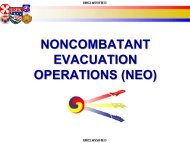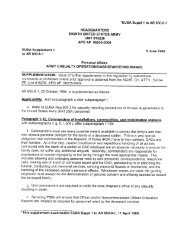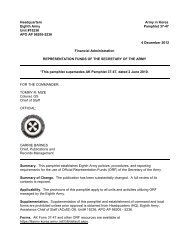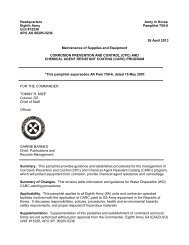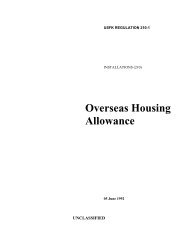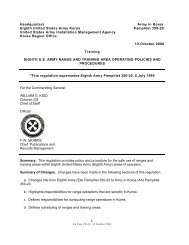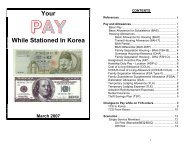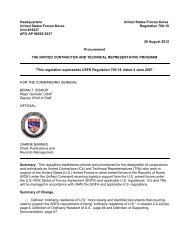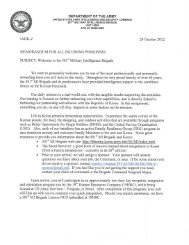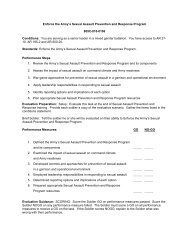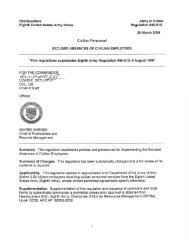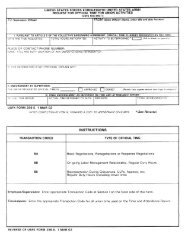CAS3 Staff Officer Guide - U.S. Army
CAS3 Staff Officer Guide - U.S. Army
CAS3 Staff Officer Guide - U.S. Army
You also want an ePaper? Increase the reach of your titles
YUMPU automatically turns print PDFs into web optimized ePapers that Google loves.
83<br />
<strong>Staff</strong> <strong>Officer</strong>'s <strong>Guide</strong><br />
9.3 Formal Memorandum<br />
Mr. Smith, ABCA-SO, DSN 999-3344<br />
rsmith@riley.army.mil<br />
Approved By: Ms. Nelson<br />
Encl 1<br />
a. Use. The formal memorandum is used for correspondence that is sent off the installation, for<br />
policy directives, or for personal correspondence sent through the chain of command to an individual.<br />
b. General format. Use white letterhead stationary for the first page and plain white paper for<br />
continuing pages. Make every attempt to keep the memorandum to two pages; however, a single page<br />
is ideal. Should you feel the information you are providing requires more than two pages, summarize<br />
the essential points in the body of the memorandum and provide the details in enclosures. The left<br />
and right margins are 1-inch margins. Set the top margin so the text begins on the second line below<br />
the seal. Set the bottom margin to 1 inch. Use the standard Times New Roman 12 font.<br />
c. Heading information. Type the proponent office symbol on the second line below the seal,<br />
then use the tab function and space bar to place the date as far to the right margin as possible.<br />
d. Address line. Type MEMORANDUM FOR (all caps) three lines below the office symbol,<br />
followed by the recipient. Address the memorandum to the particular office that will complete the<br />
action or needs the information. Give the full postal street address and zip code. If the address<br />
extends to a second line, continue the address on the next line so that the beginning is at the left<br />
margin.<br />
e. Subject. Type SUBJECT: (all caps with a colon) two lines below the last line of the address,<br />
followed by a short subject title. Capitalize the first letter of the key words in the title. Keep the<br />
subject brief; rarely should the subject extend to two lines. Do not use a period after the subject.<br />
f. Paragraph headings. Use paragraph headings to suit your style and organization. Paragraph<br />
headings tend to make the document easier to scan. If you use paragraph headings, capitalize the key<br />
words of the heading for numbered paragraphs. Do not bold, underline, or italicize the heading.<br />
g. Text. The first paragraph of the text begins on the third line below the last line of the subject.<br />
At this point, the format for the remainder of the formal memorandum, including any continuation<br />
pages, is the same as the format for the informal memorandum.<br />
Format of the Authority Line.<br />
a. Paragraph 3-11 of this <strong>Guide</strong> explains the use of the authority line. Authority lines are<br />
appropriate for use with all correspondence described in AR 25-50. Remember not to use the<br />
pronouns “I,” “me,” or “my,” when preparing correspondence that will be signed “FOR THE<br />
COMMANDER” or “FOR THE DIRECTOR.”<br />
b. When you use an authority line, type FOR THE COMMANDER: (all caps with a colon) on<br />
the second line below the last line of the text. If writing for the director, type FOR THE DIRECTOR:<br />
in the same location. Begin the signature block on the fifth line below the authority line (which is the<br />
© 2005 <strong>CAS3</strong> For Instructional Purposes Only<br />
Compiled by www.<strong>Army</strong>Toolbag.com



